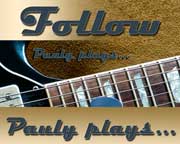The Guitar Fretboard Explorer's controls
The Fretboard Explorer's upper portion contains all of the controls that modify the display. It is fairly simple once you get used to a few things that are somewhat counter-intuitive, but make sense once you start using it. The bottom part of the display shows a 17-fret guitar neck with symbols on it that show your selection's notes. It was described in the "Fretboard Explorer introduction" article.)

One good use for the Explorer is to see the differences (or lack of them) between two scales and learn about modes. For instance, the current display shows a scale in the key of A using the Aeolian mode. You could then select the key of C using the Ionian mode and learn that the location of the notes is unchanged.
The controls
There are few areas that the controls can be grouped into. The most basic split is between if the saved state is updated. Another is if they have an immediate effect on the display. All of the buttons that save the state also immediately change the display.
Key
The Key selector never changes the display. It must always be selected before using any button that will change the display.
Last
The Last button retrieves the data that was saved when one of the buttons that affect the saved state was previously clicked. The display uses the current Display Style and Tuning selections on the retrieved data.
Scale and chord selectors

All of the button in the circled area of Figure 1 cause the display to change. They also save the current display for recall using the "Last" button. None of the other buttons affect what is saved as the Last display.
The buttons are self explanatory, with the exception of Select Scale. Clicking that causes the display to update using the items chosen in the Modal Scales section, the boxes immediately above it.. Please learn about Modes elsewhere if you don't know what they are.
The most common scales, such as the ones commonly called Major and Minor, are Diatonic scales. The other selections available for Scale Type are Melodic Minor and Harmonic Minor.
The Mode sector changes depending on the Scale Type selection. Once you have selected the Scale Type and Mode, click on the Select Scale button. Don't forget that the key must be selected first.
Display style
There are 3 types of display styles: Normal, Enhanced and Numbered. A Change in the display style happens immediately. It is not included in a saved display's information, so both the current and any recalled saved states are affected.
Each type highlights notes in a different way to make it easier to pick out certain features. The root is always drawn with a box instead of a circle. The other differences are:
- Normal — All non-root notes are displayed identically.
- Enhanced — The third is a large, light circle. The fifth is a large, dark circle. All other notes are small circles.
- Numbered — All notes are the same size and are numbered with the degree of the note.
Put another way, in terms of the note's degree, the enhanced display shows:
- 1 — Always a box.
- 3 — the third as a large, light circle.
- 5 — the fifth as a large, dark circle.
Tuning
This button immediately changes the display to represent the selected guitar tuning. It does not part of the saved state, so it will also affect the appearance of what is shown when the Last button is clicked.
Go do it
That should be enough to get you using the Guitar Fretboard Explorer, so go do it.


